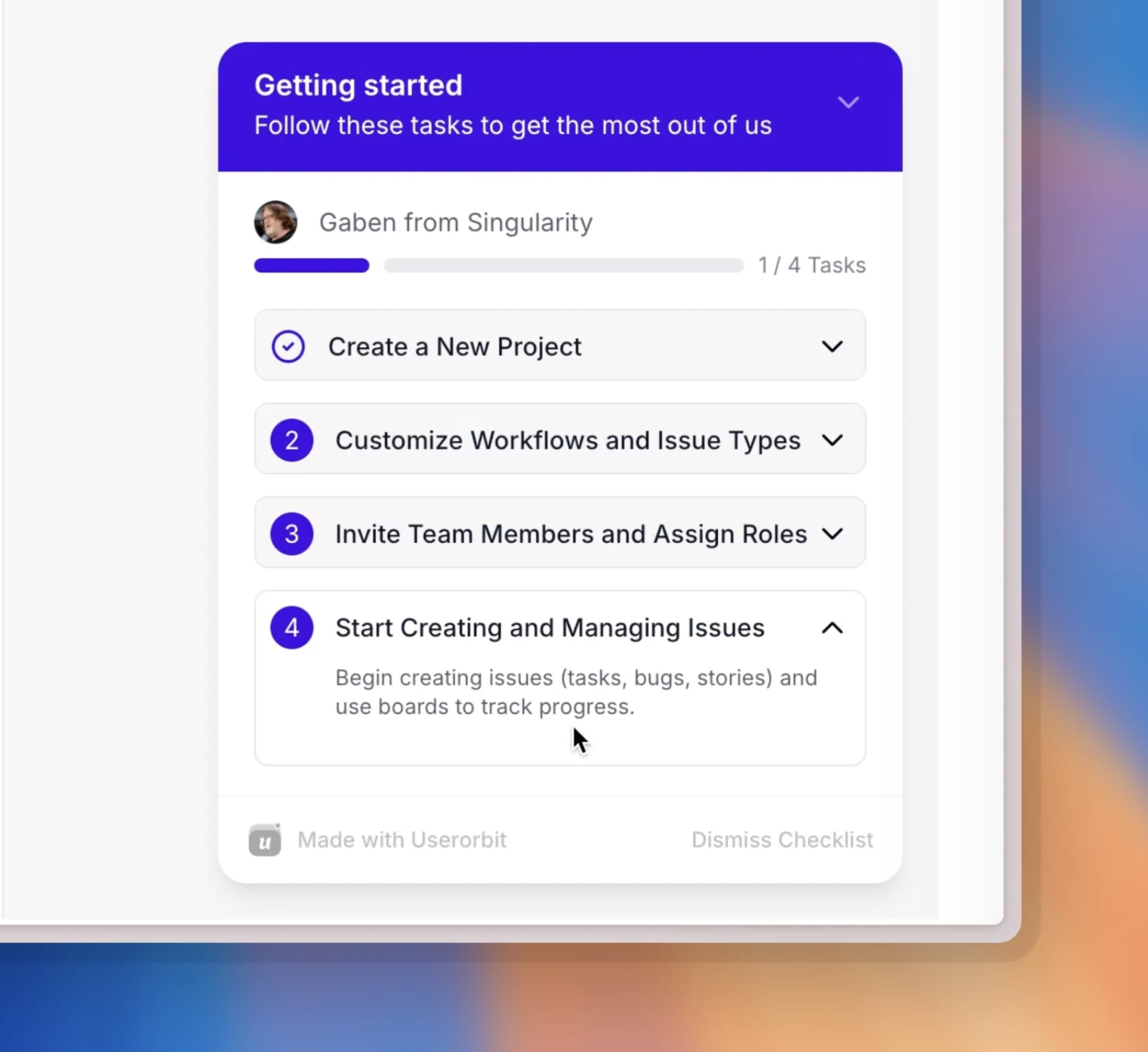Your users are confused. They downloaded your app, signed up for your service, or bought your product, but now they're staring at an interface that feels overwhelming. Most users drop off before they see real value, creating the adoption problem that's quietly killing your growth.
The solution lies in checklists and personalized guides. These simple tools transform confused visitors into power users by creating clear paths from confusion to competence. When implemented correctly, they can dramatically accelerate the journey from signup to success.

Why Users Abandon Products
Picture this scenario: Sarah signs up for your project management tool and finds herself staring at a blank dashboard filled with buttons she doesn't understand. Without guidance, she feels lost and closes the tab within minutes. This experience is far more common than most companies realize.
Research consistently shows that most users abandon products within the first week-not because the product lacks value, but because they never figured out how to extract that value. Checklists and guides fix this fundamental problem by creating a clear path from "What is this?" to "I can't live without this!" They provide the scaffolding users need to build confidence and competence.
The Checklist Advantage
Checklists work because our brains have an inherent dislike for unfinished tasks, a phenomenon known as the Zeigarnik effect. When users start a checklist, they feel psychologically compelled to complete it, creating natural momentum toward adoption.
Make Onboarding Stupid Simple
The key is breaking complex setups into bite-sized, manageable steps. Keyhole demonstrated the power of this approach and saw their trial-to-paid conversions jump an impressive 550%. Their secret weapon was a simple four-step checklist that guided users through connecting social accounts, setting up their first campaign, viewing analytics, and scheduling their first post.
Each completed step builds momentum and releases a small hit of dopamine, creating a positive feedback loop. Users get hooked on the progress before they fully realize the product's value, but by then they're already invested in the experience.
Use Psychology to Your Advantage
Smart companies layer psychological triggers into their checklists to increase completion rates. FOMO works exceptionally well-phrases like "Complete setup by Friday to unlock your bonus feature" suddenly make that checklist feel urgent and important. The ownership effect also plays a crucial role; when users invest time completing tasks, they begin to feel like they own the product, making them less likely to abandon it.
Social proof can be seamlessly woven into checklist items with testimonials like "90% of users who completed this step boosted their efficiency by 30%." These small touches of validation help users feel confident they're on the right path.
Think Beyond Software
While checklists are commonly associated with software onboarding, they're equally powerful for physical products. A smart thermostat company could guide users through installation, Wi-Fi connection, app download, temperature preferences, and schedule programming. Adding QR codes that link to video tutorials makes the experience even more seamless and reduces support burden.
Personalized Guides Hit Different
One-size-fits-all onboarding is becoming increasingly ineffective as users expect experiences tailored to their specific needs and contexts. Personalized guides acknowledge that different users have different goals, experience levels, and use cases.
Segment Like Your Revenue Depends on It
Because it absolutely does. Pinterest asks new users about their interests during signup, while HubSpot creates separate experiences for marketing and sales users. This segmentation leads to dramatically higher engagement across all user types because the content feels relevant and valuable.
A fitness equipment brand could offer completely different guides based on user goals: "Beginner's First Workout," "Advanced Strength Training," or "Cardio for Weight Loss." It's the same product, but three distinctly different experiences that speak directly to each user's needs and aspirations.
Guide Users in Real-Time
The most effective guides appear exactly when users need them, responding to their actions and context. When someone hovers over a confusing button, a helpful tooltip appears. When they get stuck on a feature, an interactive walkthrough activates automatically.
Kommunicate uses this approach with interactive walkthroughs that guide users through their chat platform based on real-time behavior. The result is faster setup completion and significantly higher long-term retention because users never feel lost or abandoned.
Let AI Do the Heavy Lifting
Predictive analytics can anticipate user needs based on their behavior patterns. If someone frequently uses your reporting feature, the system can suggest advanced templates. If they're exploring integrations, it can proactively show them API documentation or popular workflow examples.
Tools like Heap's Illuminate feature automatically spot these opportunities, making your guides smarter without requiring additional manual work from your team. This creates a more intuitive experience that feels almost magical to users.
Keep Users Engaged After Onboarding
Most companies make the critical mistake of stopping their guidance efforts after the first week, but post-onboarding engagement is where the real retention magic happens. Users who continue discovering value months after signup become your most loyal advocates and highest-value customers.
Post-onboarding checklists can introduce advanced features that users might never discover on their own. Airtable excels at this approach, using in-app prompts to show users new use cases and workflows months after their initial signup. They create "What's Next?" checklists that adapt to user behavior: power users receive advanced feature guides, casual users see workflow templates, and enterprise users get team collaboration tips.
Get Your Whole Team Involved
Product adoption isn't solely the product team's responsibility-it requires coordinated effort across your entire organization. When customer success, marketing, and sales teams work together around adoption goals, the results compound significantly.
Customer success teams should be trained to reach out when users stall on checklist tasks, as a well-timed message can unstick blocked users and prevent churn. Marketing teams can use guide interaction data to create highly targeted campaigns, emailing users about features they haven't explored yet. Sales teams benefit from persona-specific guides that help them address prospect pain points during demos with relevant, concrete examples.
Make Guides Work for Everyone
Your user base is diverse, speaking different languages, having different abilities, and coming from various backgrounds. Designing for inclusion isn't just the right thing to do-it's also good business that expands your addressable market.
This means offering guides in multiple languages, using high-contrast text for better readability, keeping language simple for non-technical users, and regularly testing with diverse user groups to identify blind spots. Tools like UserGuiding support multilingual content out of the box, making implementation straightforward.
Measure and Improve
The best guides evolve continuously based on real user data and feedback. Track metrics that actually matter: activation rates show how many users complete core actions, feature adoption reveals which capabilities guided users discover, and customer effort scores indicate how difficult it is to extract value from your product.
A/B test everything from checklist length to specific wording choices. Userpilot and similar tools make this testing straightforward with built-in experimentation features. Create feedback loops where user behavior informs product improvements-if users consistently abandon a particular checklist step, investigate whether that feature needs simplification or better explanation.
Real Results from Real Companies
The impact of well-designed checklists and guides shows up clearly in company metrics. Keyhole's onboarding checklist generated a 550% increase in conversions. A hypothetical online bookstore implementing purchase checklists could realistically expect a 20% reduction in cart abandonment. Smart home device companies providing comprehensive setup guides typically see 90% successful installations without requiring support calls.
Your Next Steps
Start with simplicity by picking your three most important features and creating a checklist that guides users through each one. Add progress bars because users love seeing their advancement visually represented. Personalize the experience based on user type, since different roles genuinely need different guidance approaches.
Use no-code tools like Userorbit, Userpilot, or Appcues for quick implementation, and remember that your first version won't be perfect-that's completely fine and expected. The key is starting and then iterating based on what you learn from real user behavior.
The Bottom Line
Checklists and personalized guides transform product confusion into genuine product adoption. They're not nice-to-have features-they're growth engines that directly impact your bottom line. Your users genuinely want to succeed with your product, so give them the roadmap they need.
Pick one core workflow today, break it into clear steps, and start guiding your users toward success. They'll thank you for the clarity, and your revenue will reflect their satisfaction.
